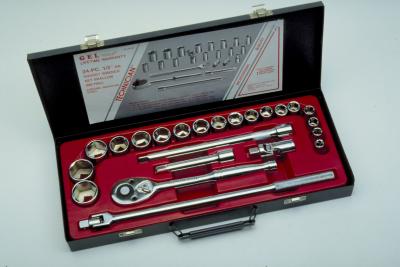
The 1991 Toyota Celica GT has a freewheeling engine. Should the timing belt break or stretch past its usefulness, there is little chance that the valves could hit the pistons and cause major engine damage. The manufacturer recommends you change the GT's timing belt every 60,000 miles. You need a special tool to complete the procedure, and it is available through the Toyota dealer. It takes approximately five hours to change the timing belt in the Celica GT.
Disconnect the battery's ground cable and lay the cable aside. Jack up the Celica GT and support it with jack stands. Remove the engine splash guard and the intercooler using the appropriate sockets. Remove the accessory drive belt by loosening the tensioner and removing tension on the belt.
Remove the alternator and its bracket using the appropriate socket and wrench. Remove the right front wheel using the lug wrench. Remove the right fender apron shield using the appropriate size socket.
Place the block of wood on the floor jack. Support the engine with the floor jack by jacking it up just until it touches the bottom of the engine. Remove the right engine mount and the mount bracket using the appropriate sockets. Remove the upper timing belt cover.
Turn the crankshaft clockwise until the timing marks on the crankshaft and the camshaft line up. If the marks do not line up the first time around, turn the engine again, and the marks should line up. The crankshaft mark is at 11 o'clock and the camshaft timing marks are at 12 o'clock.
Remove the auto tensioner securing bolts and the auto tensioner using the appropriate sockets. Remove the crankshaft pulley bolt using the appropriate socket. Remove the pulley using the special tool #09213-31021. Remove the lower timing belt cover and the belt guide washer. Remove the tensioner pulley retaining bolt and the tensioner pulley using the appropriate sockets. Remove the timing belt. Check the tensioner pulley to make sure it rotates smoothly. If not, replace the tensioner pulley.
Install the tensioner pulley and tighten the bolt to 38 foot-pounds of torque. Inspect the auto tensioner for oil leakage. If it leaks, replace it. Press the pushrod against a hard surface. If you can move the pushrod, replace the auto tensioner. Measure the pushrod where it exits the auto tensioner. If the measurement is not between .34 and .37 inches, replace it.
Install the timing belt, starting at the crankshaft sprocket and oil pump sprocket (at the same time) and working counterclockwise around the guide pulley and water pump pulley. Install the belt guide washer and the timing belt lower cover.
Install the crankshaft pulley and the crankshaft pulley bolt. Tighten the crankshaft pulley bolt to 80 foot-pounds of torque. Check the crankshaft timing mark to ensure it is still aligned. The notch in the pulley should line up with the zero mark on the timing scale printed on the block.
Install the timing belt around the camshaft sprockets and behind the tensioner pulley, keeping the timing belt tight on the non-tensioned side (right side while facing the engine).
Push the pushrod in the auto tensioner using a vise or press. Insert an Allen wrench through the hole in the body of the auto tensioner and into the hole in the pushrod once they line up to hold the pushrod in place. Tighten the tensioner pulley bolt to 13 foot-pounds of torque. Install the auto tensioner. Tighten the bolts just enough to hold it in place. Leave the torque wrench on the bolt, ensuring that the handle lines up with the camshaft sprocket.
Turn the crankshaft clockwise 5/6 of a turn, aligning the crankshaft pulley mark (the pointer mark, not the notch mark) with the 60-degree BTDC mark on the timing cover.
Loosen the auto tensioner bolts. Insert the 0.75-inch feeler gauge between the auto tensioner's body and the tensioner pulley bracket. Hold the tensioner in place and tighten the auto tensioner bolts to 15 foot-pounds of torque. Remove the feeler gauge, the Allen wrench and the torque wrench from the tensioner pulley bolt.
Turn the crankshaft clockwise for one turn, lining up the crankshaft pulley mark (the notch, not the pointer) to the 60-degree BTDC mark on the timing cover. Measure the distance between the auto tensioner body and the tensioner pulley bracket with the feeler gauges. The measurement needs to be between 0.071 and 0.087 inches. If the clearance is incorrect, repeat the entire timing belt installation procedure.
Turn the crankshaft clockwise 2 1/6 turns until the No. 1 cylinder is at top dead center. To ensure the No. 1 cylinder is at top dead center, insert a long screwdriver into the spark plug hole while turning the engine. When you feel the piston come up to the top of the bore, the cylinder is at top dead center. Check that the timing marks are still lined up. Install the rest of the parts in reverse order of removal.